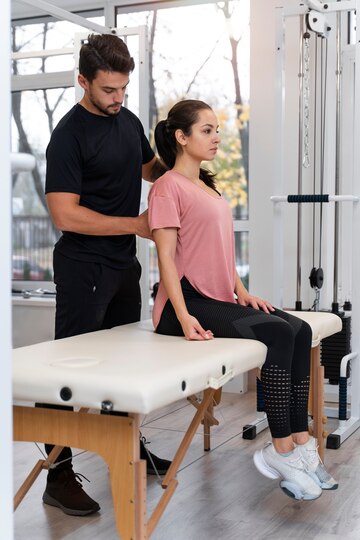Table of Contents
Physiotherapy in Langley
Poor posture isn’t just a matter of appearance; it significantly impacts your health, including your back pain, neck pain, and headaches. In this blog, we’ll cover how poor posture is linked to these common conditions and how an expert physiotherapy in Langley can offer effective relief and prevention strategies.
The Impact of Poor Posture on Your Health
How Poor Posture Contributes to Back Pain
Poor posture can be a major contributor to back pain. When you slouch or hunch over, your spine is forced into an unnatural position, which puts excessive stress on the spine and its surrounding muscles. Gradually, this can lead to chronic pain, discomfort, and reduced mobility.
Sitting for long periods with poor posture—such as leaning forward or slumping—can compress the lumbar discs, resulting in pain and stiffness. Additionally, poor posture often leads to muscle imbalances: some muscles become overused and tight, while others become weak and stretched. This imbalance makes back pain and can make everyday activities more uncomfortable.

Neck Pain and Poor Posture
Neck pain is another common issue linked to poor posture. Holding your head forward or tilting it at an awkward angle for extended periods increases the strain on the cervical spine and neck muscles. This forward head posture places added stress on the neck, leading to muscle strain, disc issues, and nerve compression.
Common activities like working at a desk with poor ergonomics or constantly looking down at a phone can worsen neck pain. Over time, this can result in conditions such as cervical spondylosis or herniated discs, which can be particularly painful and limiting.
The Connection Between Poor Posture and Headaches
Poor posture can also be a trigger for tension-type headaches. When the muscles in your neck and upper back become tight due to poor posture, they can create tension that radiates into your head, leading to headaches. This tension often feels like a tight band around the forehead.
In addition, poor posture can reduce circulation and cause nerve irritation, further exacerbating headache issues. Prolonged slouching or sitting with poor posture can also decrease oxygen flow to the brain, which can trigger headaches or migraines.
How Physiotherapy Can Help
Physiotherapy for Back Pain Relief
Physiotherapy can be highly effective in treating back pain associated with poor posture. Physiotherapists use various techniques to relieve pain, improve spinal alignment, and strengthen the muscles that support the back. Common treatments include:
- Manual Therapy: Techniques such as joint mobilization and spinal manipulation can help realign the spine and reduce pain.
- Exercise Therapy: Customized exercise programs strengthen core muscles, enhance flexibility, and correct muscle imbalances caused by poor posture.
- Postural Education: Physiotherapists provide guidance on proper sitting and standing postures to prevent future back pain.
By addressing the root causes of back pain through physiotherapy, individuals can achieve long-term relief and reduce the likelihood of recurrence.
Managing Neck Pain
For neck pain resulting from poor posture, physiotherapy offers targeted treatments to alleviate discomfort and restore function. Effective approaches include:
- Stretching and Strengthening Exercises: Specific exercises improve the flexibility and strength of neck muscles, reducing strain and preventing future issues.
- Postural Correction: Physiotherapists teach strategies to correct poor posture habits and lessen strain on the neck.
- Manual Techniques: Massage and trigger point therapy can help relax tight muscles and reduce pain.
These methods can significantly improve neck pain and overall well-being.
Treating Headaches Through Physiotherapy
When headaches are related to poor posture, physiotherapy can provide effective relief by addressing the underlying muscular and postural issues. Treatment options include:
- Cervical Mobilization: Techniques to improve the movement and alignment of the cervical spine can reduce headache frequency and severity.
- Muscle Relaxation: Techniques to release tension in the neck and upper back muscles can alleviate headache symptoms.
- Postural Training: Educating patients on maintaining proper posture helps prevent posture-related headaches.
By targeting the muscular and postural factors contributing to headaches, a professional physiotherapy session in Langley can offer lasting relief and enhance overall quality of life.
Prevention and Maintenance
The Role of Regular Physiotherapy
Maintaining good posture is essential for preventing back pain, neck pain, and headaches. Regular physiotherapy can be instrumental in this preventive approach by offering:
- Routine Assessments: Physiotherapists can evaluate your posture and musculoskeletal health to identify and address issues early.
- Ongoing Education: Continuous guidance on proper posture and ergonomic practices can help prevent future problems.
- Customized Exercise Programs: Personalized exercise routines strengthen muscles and improve posture over time.
Incorporating regular physiotherapy into your wellness routine can help you maintain optimal posture, reduce the risk of related ailments, and improve overall health.
Physiotherapy in Langley | Physiotherapy in Langley
Conclusion
Poor posture is a crucial factor in the development of back pain, neck pain, and headaches. Understanding how poor posture affects your health is the first step toward addressing these issues. Physiotherapy can offer effective solutions for managing and preventing these common conditions through targeted treatments, posture correction, and ongoing education. If you’re experiencing any negative effect of poor posture, consider consulting with expert physiotherapy in Langley at Carvolth Physiotherapy for better health and comfort.
Physiotherapy in Langley | Physiotherapy in Langley | Physiotherapy in Langley | Physiotherapy in Langley | Physiotherapy in Langley

 +1987 123456
+1987 123456 info@example.com
info@example.com +9987 554855
+9987 554855